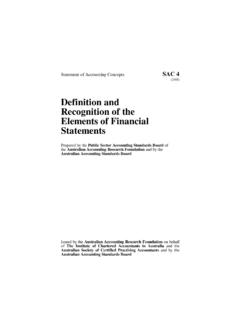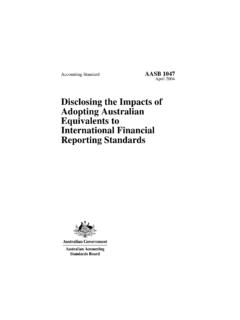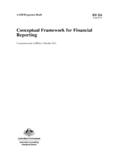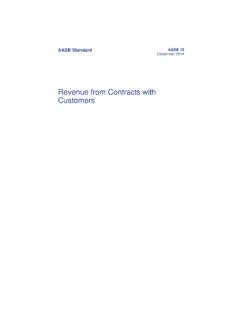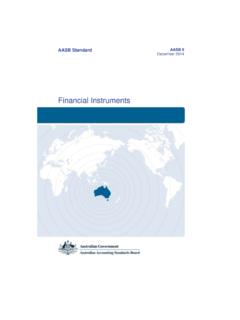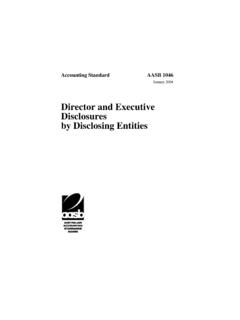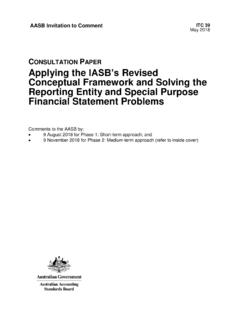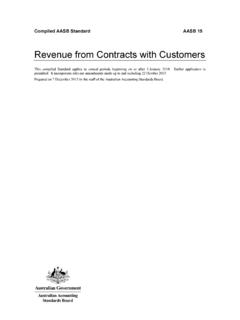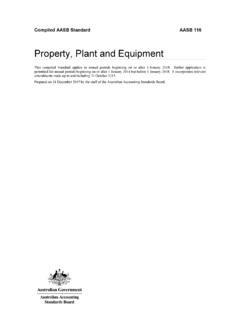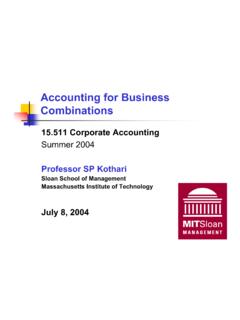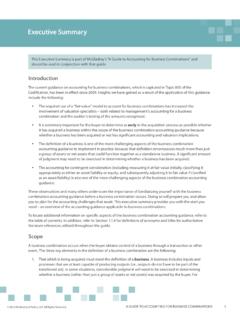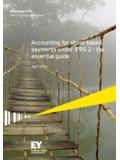Transcription of Compiled AASB 3 (Jun 2010)
1 Compiled aasb Standard RDR Early Application Only aasb 3 business Combinations This Compiled Standard applies to annual reporting periods beginning on or after 1 July 2009 but before 1 July 2010 with early application of the Reduced Disclosure Requirements (RDR). It incorporates relevant amendments made up to and including 30 June 2010. RDR amendments cannot be applied to periods beginning before 1 July 2009. Prepared on 29 July 2010 by the staff of the Australian Accounting Standards Board. aasb 3- Compiled RDR early application only 2 COPYRIGHT Obtaining Copies of Accounting Standards Compiled versions of Standards, original Standards and amending Standards (see Compilation Details) are available on the aasb website: Printed copies of original Standards and amending Standards are available for purchase by contacting: The Customer Service Officer Australian Accounting Standards Board Level 7 600 Bourke Street Melbourne Victoria AUSTRALIA Postal address: PO Box 204 Collins Street West Victoria 8007 AUSTRALIA Phone: (03) 9617 7637 Fax: (03) 9617 7608 E-mail: Website: Other Enquiries Phone: (03) 9617 7600 Fax: (03) 9617 7608 E-mail.
2 COPYRIGHT 2010 Commonwealth of Australia This Compiled aasb Standard contains International Accounting Standards Committee Foundation copyright material. Reproduction within Australia in unaltered form (retaining this notice) is permitted for personal and non-commercial use subject to the inclusion of an acknowledgment of the source. Requests and enquiries concerning reproduction and rights for commercial purposes within Australia should be addressed to The Director of Finance and Administration, Australian Accounting Standards Board, PO Box 204, Collins Street West, Victoria 8007. All existing rights in this material are reserved outside Australia. Reproduction outside Australia in unaltered form (retaining this notice) is permitted for personal and non-commercial use only.
3 Further information and requests for authorisation to reproduce for commercial purposes outside Australia should be addressed to the International Accounting Standards Committee Foundation at aasb 3- Compiled RDR early application only 3 CONTENTS CONTENTS COMPILATION DETAILS COMPARISON WITH IFRS 3 ACCOUNTING STANDARD aasb 3 business COMBINATIONS Paragraphs Objective 1 Application Reduced disclosure requirements Scope 2 Identifying a business combination 3 The acquisition method 4 5 Identifying the acquirer 6 7 Determining the acquisition date 8 9 Recognising and measuring the identifiable assets acquired, the liabilities assumed and any non-controlling interest in the acquiree Recognition principle 10 Recognition conditions 11 14 Classifying or designating identifiable assets acquired and liabilities assumed in a business combination 15 17 Measurement principle 18 20 Exception to the recognition or measurement principles 21 Exception to the recognition principle Contingent liabilities 22 23 Exceptions to both the recognition and measurement principles Income taxes 24 25 Employee benefits 26 Indemnification assets 27 28 Exceptions to the measurement principle Reacquired rights 29 Share-based payment awards 30 Assets held for sale 31 aasb 3- Compiled RDR early application only 4
4 CONTENTS Recognising and measuring goodwill or a gain from a bargain purchase 32 33 Bargain purchases 34 36 Consideration transferred 37 38 Contingent consideration 39 40 Additional guidance for applying the acquisition method to particular types of business combinations A business combination achieved in stages 41 42 A business combination achieved without the transfer of consideration 43 44 Measurement period 45 50 Determining what is part of the business combination transaction 51 52 Acquisition-related costs 53 Subsequent measurement and accounting 54 Reacquired rights 55 Contingent liabilities 56 Indemnification assets 57 Contingent consideration 58 Disclosures 59 63 Restructures of local governments Effective date and transition Transition 65 66 Income taxes 67 Appendices: A.
5 Defined Terms Page 31 B. Application Guidance Page 33 DELETED IFRS 3 TEXT Page 62 ILLUSTRATIVE EXAMPLES (available on the aasb website) BASIS FOR CONCLUSIONS ON aasb 2008-11 Page 63 BASIS FOR CONCLUSIONS ON IFRS 3 (available on the aasb website) aasb 3- Compiled RDR early application only 5 CONTENTS Australian Accounting Standard aasb 3 business Combinations (as amended) is set out in paragraphs 1 67 and Appendices A B. All the paragraphs have equal authority. Paragraphs in bold type state the main principles. Terms defined in this Standard are in italics the first time they appear in the Standard. aasb 3 is to be read in the context of other Australian Accounting Standards, including aasb 1048 Interpretation and Application of Standards, which identifies the Australian Accounting Interpretations.
6 In the absence of explicit guidance, aasb 108 Accounting Policies, Changes in Accounting Estimates and Errors provides a basis for selecting and applying accounting policies. aasb 3- Compiled RDR early application only 6 COMPILATION DETAILS COMPILATION DETAILS Accounting Standard aasb 3 business Combinations as amended RDR Early Application Only This Compiled Standard applies to annual reporting periods beginning on or after 1 July 2009 but before 1 July 2010 with early application of the Reduced Disclosure Requirements. It takes into account amendments up to and including 30 June 2010 and was prepared on 29 July 2010 by the staff of the Australian Accounting Standards Board ( aasb ). This compilation is not a separate Accounting Standard made by the aasb .
7 Instead, it is a representation of aasb 3 (March 2008) as amended by other Accounting Standards, which are listed in the Table below. Table of Standards Standard Date made Application date (annual reporting periods .. on or after ..) Application, saving or transitional provisions aasb 3 6 Mar 2008 (beginning) 1 Jul 2009 see (a) below aasb 2008-11 13 Nov 2008 (beginning) 1 Jul 2009 see (b) below aasb 2009-11 7 Dec 2009 (beginning) 1 Jan 2013 not Compiled * aasb 2010-3 23 Jun 2010 (beginning) 1 Jul 2010 not Compiled * aasb 2010-2 30 Jun 2010 (beginning) 1 Jul 2013 see (c) below * The amendments made by this Standard are not included in this compilation, which presents the principal Standard as applicable to annual reporting periods beginning on or after 1 July 2009 but before 1 July 2010 with early application of the Reduced Disclosure Requirements set out in aasb 2010-2.
8 (a) For-profit entities may elect to apply this Standard to annual reporting periods beginning on or after 30 June 2007 but before 1 July 2009, provided that aasb 127 Consolidated and Separate Financial Statements (March 2008) is also applied to such periods. (b) Entities may elect to apply this Standard to annual reporting periods beginning on or after 30 June 2007 but before 1 July 2009, provided that aasb 127 Consolidated and Separate Financial Statements (March 2008) is also applied to such periods. (c) Entities may elect to apply this Standard (the RDR amendments) to annual reporting periods beginning on or after 1 July 2009 but before 1 July 2013, provided that aasb 1053 Application of Tiers of Australian Accounting Standards is also applied to such periods.
9 aasb 3- Compiled RDR early application only 7 COMPILATION DETAILS Table of Amendments Paragraph affected How affected By .. [paragraph] amended aasb 2008-11 [5] amended aasb 2008-11 [6] added aasb 2008-11 [7] (and preceding heading) added aasb 2010-2 [16] (and preceding heading) added aasb 2008-11 [8] added aasb 2010-2 [16] added aasb 2010-2 [16] Basis for Conclusions on aasb 2008-11 The Basis for Conclusions accompanying aasb 2008-11 Amendments to Australian Accounting Standard business Combinations Among Not-for-Profit Entities is attached to this Compiled 3- Compiled RDR early application only 8 COMPARISON COMPARISON WITH IFRS 3 aasb 3 and IFRS 3 aasb 3 business Combinations as amended incorporates IFRS 3 business Combinations as issued and amended by the International Accounting Standards Board (IASB).
10 Paragraphs that have been added to this Standard (and do not appear in the text of IFRS 3) are identified with the prefix Aus or RDR , followed by the number of the preceding IASB paragraph and decimal numbering. Compliance with IFRS 3 For-profit entities that comply with aasb 3 as amended will simultaneously be in compliance with IFRS 3 as amended. Not-for-profit entities using the added Aus paragraphs in the Standard that specifically apply to not-for-profit entities may not be simultaneously complying with IFRS 3. Whether a not-for-profit entity will be in compliance with IFRS 3 will depend on whether the Aus paragraphs provide additional guidance for not-for-profit entities or contain requirements that are inconsistent with the corresponding IASB Standard and will be applied by the not-for-profit entity.
